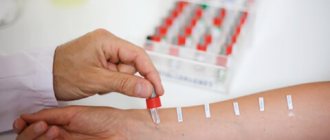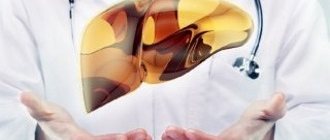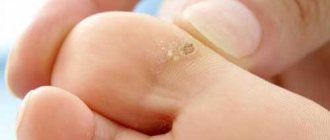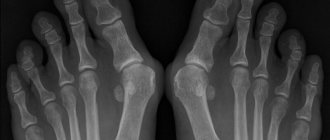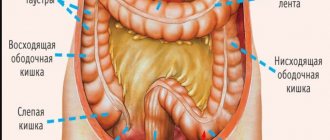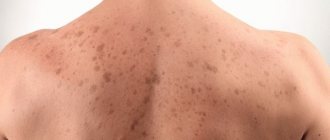Nature and history of psoriasis
The first mentions of the symptoms of a skin disease were found in the annals of healers of Ancient Egypt and India. It was described in detail by Hippocrates, who gave the name “psora” to red plaques and papules on the body. In the Middle Ages, it was long considered a type of dangerous leprosy, so patients hid the inflammation to avoid forced treatment.
Psoriasis was first identified as a separate disease by the German dermatologist and scientist Ferdinant von Hebr in 1841. He conducted an extensive study with epithelial sampling and described in detail all stages and types of the inflammatory process. His follower Jean Louis Alibert linked the disease to a specific form of arthritis.
Detailed study of psoriasis began in the 20th century. With the help of better equipment and optics, doctors learned that during illness, the processes of skin regeneration and exfoliation are accelerated by 8–10 times. They separated the pathology from dermatitis and proved its autoimmune nature.
In recent years, it has been possible to identify the main factors that increase the risk of psoriasis. But doctors continue to look for the causes of the disease; the influence of immunity and heredity is being considered. To date, hundreds of drugs have been developed for treatment, but not a single method relieves the patient of the problem forever.
Shampoos
To treat psoriasis of the scalp, Etrivex shampoo containing the glucocorticoid clobetasol is used. This active substance reduces inflammation, constricts blood vessels in the skin, and reduces itching. The duration of the course of treatment is no more than 4 weeks, during which the drug is applied to dry scalp, left for 15 minutes, and then rinsed off. If after this the patient has a small number of papules left, then this shampoo for psoriasis is used twice a week for six months.
Other shampoos used for psoriatic scalp lesions contain tar. Algopix, Friederm Tar, “Tar 911”, Psorilom are products from this group.
Algopix contains juniper tar, alcohol extract of microalgae, and salicylic acid. Due to its anti-inflammatory, antifungal, healing effect, it is used not only for psoriasis, but also for other dermatological pathologies.
Friederm Tar psoriasis shampoo includes coal tar. The product reduces itching, inflammation, promotes exfoliation of scales, removes excess sebum, destroys bacteria and fungi on the surface of the skin.
Shampoo “Tar 911” eliminates excess flaking and itching due to psoriasis thanks to birch tar in the composition.
Psoril is a combination product with birch tar, extracts of St. John's wort, string, and celandine. The shampoo gently cleanses the hair and scalp, removing dead particles of the epidermis, excess sebum, eliminates itching, and has anti-inflammatory and antiseptic effects.
For scalp psoriasis, shampoos designed to treat dandruff can be used. Such products have a softening, exfoliating effect, and are most effective for concomitant fungal infections. Representatives of this group are Sulsena, Nizoral.
Skin-Cap, a shampoo containing zinc pyrithione, is also used for washing hair during psoriatic process. The drug relieves itching, peeling, moisturizes the skin, reduces the severity of inflammatory reactions.
Main causes of psoriasis
In a healthy person, the process of renewal of the upper layer of the dermis takes 21–30 days. During this time, the cell is formed, grows, performs basic functions and dies, making room for a new one. Under the influence of negative factors in psoriasis, the process accelerates several times, taking no more than 5–6 days.
Most dermatologists believe that the main cause of the disease is autoimmune disorders. For unknown reasons, the human immune system begins to attack its own skin cells, which provokes an inflammatory process. They do not have time to mature and are torn away from the deeper layers, forming itchy plaques.
Among the main causes and factors provoking the development of the disease:
- decline in immunity;
- frequent colds, ARVI or flu;
- hormonal imbalance;
- pathologies of the thyroid gland;
- constant hypothermia;
- working with chemicals;
- psychological problems, stress, disorders;
- drug or alcohol use.
Recent scientific developments suggest several hypotheses related to the causes of the disease. They are based on observations of different groups of patients:
- hidden allergies to foods, medications or environmental factors;
- infections and inflammatory foci in internal organs;
- disruption of metabolic processes affecting tissue regeneration;
- presence of parasites;
- psychosomatics.
Psoriasis is often inherited. If both parents have the gene, the risk of encountering pathology increases to 50%. In most cases, the first manifestations of the disease are observed during puberty and the final formation of the body - from 15 to 20 years.
Many patients manage to avoid painful manifestations with the help of diet and a healthy lifestyle. But doctors identify several factors that can cause exacerbation and frequent relapses:
- smoking;
- infectious skin diseases;
- side effects of certain medications;
- complications after vaccination;
- Tan;
- stressful situations.
The occurrence of psoriasis in most cases is a combination of several factors. It worsens after suffering from bronchitis or tonsillitis, in the treatment of which antibiotics were used. It is always associated with a decline in immunity and weakening of the body.
What causes scaly lichen in adults and children?
With psoriasis, purple or pink spots form on the skin and peel. The disease is often called lichen planus. Pathology develops for various reasons. Most often it is genetic in nature.
Factors causing symptoms of psoriasis in adults:
- increased skin dryness;
- stress;
- working in unfavorable conditions;
- HIV infection;
- hormonal disbalance;
- bad habits;
- taking immunomodulatory drugs;
- sudden climate change;
- infectious pathologies;
- fungal infections.
Reasons for the development of psoriasis in children:
- rubella;
- stress;
- starvation;
- decreased immunity;
- allergy;
- unbalanced diet.
If a pregnant woman smoked, drank alcohol, or took drugs that affect the immune system, then her child has an increased chance of developing psoriasis.
Dangerous complications of psoriasis
Itching, burning and plaques on the skin are not the only manifestations. The inflammatory process can affect internal organs and systems, and switch to joints. The level of toxins in the blood constantly increases, disrupting metabolic processes.
The main problem with advanced psoriasis is the development of arthritis. It is diagnosed in 15–20% of patients at different stages and occurs with frequent relapses and painful inflammation of the joints. Most often, the process involves the fingers and toes, ankles, knees and hip joints.
Other complications of psoriasis include:
- erythroderma with extensive areas of skin lesions;
- decreased visual acuity;
- expansion of the ventricles of the heart;
- kidney diseases;
- chronic intestinal disorder.
With psoriasis, the risk of severe depression and mental pathologies increases by 2–3 times. The disease is not transmitted and is not contagious, but people with a skin defect often avoid personal relationships and are embarrassed about their own body. They deliberately refuse intimate life and visiting interesting places. A biased attitude towards the problem reduces the circle of friends to a minimum.
How to achieve stable remission?
To achieve stable remission, you need to approach the problem comprehensively.
Doctors develop an effective treatment regimen for each patient that must be followed. To relieve an acute condition, medications for internal and external use are prescribed .
Physiotherapeutic techniques are used to regenerate the skin. Traditional methods enhance the effect of the main therapy.
Stabilization of the psycho-emotional background and elimination of factors that provoke the disease (wearing compressive clothing, skin trauma, exposure to aggressive substances) will help bring psoriasis into the attenuation stage.
Main symptoms and signs of psoriasis
An experienced dermatologist can easily distinguish the manifestations of the disease from other dermatitis. Several spots appear on the body, more like a rash. They quickly increase in diameter, reaching 7–8 cm, and begin to peel off. If psoriasis is not treated, the inflamed areas cover up to 50–60% of the body.
The following signs help distinguish psoriasis plaques from lichen or allergies:
- They have clear edges, are slightly thickened and raised above the skin, causing slight swelling and redness. The scales are light, almost silver in color.
- Exfoliated particles are easily scraped off the surface, leaving the surface as if covered with wax.
- After removing the inflamed scales, a thin red film of new cells is noticeable, which glitters in the light.
- When you try to peel off the film, droplets of blood appear (Auspitz phenomenon).
These are the main signs of psoriasis that help in self-diagnosis. The first manifestations are observed at the site of rubbing with clothing, after abrasions or thermal burns, resembling non-healing wounds. But there are several options for placing papules on the patient’s body:
- On hands. Small lesions can be localized on the fingers and cover the elbows with crusts. In rare cases or in advanced forms, the process affects the forearm.
- On the head. The common form is diagnosed when particles and crusts appear on the scalp. The inflammation begins at the back of the head, gradually moves behind the ears, accompanied by a burning sensation and profuse dandruff, resembling a crown.
- On the body. With a drop-shaped form, small plaques abundantly cover the abdomen, thighs, and back. The problem often occurs after treating infections with antibiotics.
- On the palms and soles. Palmoplantar psoriasis begins with a few small plaques but quickly develops into large areas covered with whitish skin. Sometimes itchy crusts appear only between the fingers.
- On the face. A rare form localized on the thin skin of the eyelids, around the lips with rashes on the cheeks.
Recently, the number of children whose psoriasis appears long before puberty has increased. In babies, the first papules are hidden in the folds of skin in the groin, armpits, and neck. They itch, causing discomfort and loss of appetite. Parents often mistake them for a manifestation of atopic dermatitis.
Diagnostics
The diagnosis is made based on the patient's clinical symptoms and complaints.
- Psoriatic triad: stearic spot symptom + film terminal symptom + blood dew symptom (all symptoms are described above). The psoriatic triad is identified sequentially by scraping the plaque with a glass slide or a blunt scalpel. This set of symptoms is typical for most patients with psoriasis. At home, it is possible to conduct such a diagnostic test for psoriasis before consulting a dermatologist.
- The presence of certain symptoms of damage to the skin, nails, joints, etc. - see above.
- In difficult cases, a skin biopsy is performed for verification (establishing an accurate diagnosis). At the same time, infiltration of lymphocytes, neutrophils and macrophages, thickening of skin capillaries, and immature keratinocytes are found in the thickness of the skin.
- X-rays of joints should ideally be done in all patients. But most often it is performed according to indications - if there are complaints of joint pain.
- A general blood test is most often normal. Inflammatory changes are detected only in severe cases of the disease. Recently, it has become common to make a diagnosis using a blood test under a microscope. This has no bearing on the diagnosis of psoriasis!
In the photo: psoriatic triad
Differential diagnosis of psoriasis is carried out with the following diseases:
- Lichen planus - read in detail the article about lichen planus
- Pityriasis rosea - read the detailed article about pityriasis rosea
- Parapsoriasis,
- Atopic dermatitis
- Eczema
- Papular syphilide
- Seborrheic dermatitis on the head
- Dermatophytosis on the head
- Reiter's disease, rheumatoid arthritis, arthrosis
- Drug allergic dermatoses
- Hives
Types and forms of the disease
Psoriasis is separately classified according to its signs and characteristic manifestations. Separation by form helps to correctly identify the main cause of the disease and select a treatment method:
- Simple, plaque-like or vulgar. The classic version appears on the skin with a large number of plaques. They are covered with silvery scales, are very flaky, itchy and can bleed when scratched. They often merge into a large formation on the back, abdomen or legs. Characterized by regular relapses and joint complications.
- Dotted or teardrop-shaped. There are many small dots no more than 1.5 cm in diameter protruding on the body. They resemble a rash and are rarely localized on the face and hands. When rubbed with seams, clothes often peel off, leaving open, inflamed skin that becomes infected with a secondary infection.
- Pustular. A complex form, in which up to 30–50% of the body is affected. An exacerbation is accompanied by enlarged lymph nodes, high fever, exacerbation of internal diseases, and requires medical care in a hospital setting. It is divided into localized and generalized Tsumbusha type.
- Exudative. One of the most severe forms. It occurs in patients with endocrine pathologies and develops against the background of diabetes. In addition to peeling, plaques secrete large quantities of inflammatory fluid. They become saturated with exudate, turning into a dense crust, causing severe pain to a person when touched or treated.
- Parapsoriasis or Broca's disease. It has similar symptoms, but the plaques are more reminiscent of eczema spots, do not have a film effect or waxy sheen, and do not emit red drops after removal. May be accompanied by fever, weakness and deterioration of health.
- Inverse or reverse. A rare form is diagnosed in 1% of people. One of the manifestations is considered to be dark pigmentation in the armpits and inguinal folds, which at the initial stage do not cause intense peeling.
As the disease progresses, seborrheic psoriasis may join the above. This form is diagnosed when itchy spots appear on the scalp. It develops quickly and spreads to the forehead, affecting the face. Patients mistake it for ordinary seborrhea, using a special shampoo. But upon visual inspection, there is no oily sheen and abundant sebaceous secretions, the skin is dry, the scales shine in the light.
Separately, doctors distinguish nail psoriasis or onychodystrophy. It resembles the vulgar form and occurs with frequent relapses. Occurs in 90% of patients with psoriatic arthritis. It occurs in only 7% of children, but is difficult to treat. Symptoms include detachment of the plate, the appearance of white spots, dents, and severe delamination.
Establishing diagnosis
To prescribe effective treatment for psoriasis, it is necessary to first determine the causes of its occurrence. If they are not eliminated, the disease will continue to recur. To do this, you need to undergo a full examination in a clinical setting.
Among the most effective diagnostic measures for lichen planus, a visual examination and collection of an anamnesis of the disease should be highlighted. Please note that there are no specific measures to detect the disease. A blood test can only show advanced forms of psoriasis. In this case, active inflammation, rheumatic and autoimmune processes will be found. Biochemical and endocrine disturbances are also possible.
Differential diagnosis For differential diagnosis, a skin biopsy is performed. Using this analysis, it is possible to determine the accumulation of T-lymphocytes, thickening of the keratinocyte layer and signs of proliferation of immunocompetent cellular structures. In the epidermal layer, under the plaques, accelerated angiogenesis is observed. Experts pay attention to the presence of pinpoint hemorrhages on the skin. When the flaky crust is scraped off, bleeding appears. This is due to the acceleration of angiogenesis processes, as well as excessive fragility of vascular structures, which is a manifestation of the Auspitz symptom, characteristic of psoriasis.
Stages of psoriasis and photos
In clinical practice, there are several stages of the disease. They differ in the severity of symptoms, manifestations, and nature of the course. Separately, many experts describe the initial one, which in many patients occurs with hidden inflammation, resembling ordinary dermatitis or lichen.
As you can see in the photo, at the initial or early stage the rash is almost invisible. Sometimes there is slight peeling on the elbows or feet, which does not cause discomfort. The burning sensation decreases after applying a moisturizer or lotion. The spots are small in diameter and do not cause concern.
When diagnosing, the following classification of psoriasis stages is used:
- Acute or progressive. The spots noticeably increase in size and become covered with dry particles of the epidermis. The patient is concerned about severe itching, burning, irritation, and swelling of the skin at the site of the rash. A red border appears around the plaques.
- Stationary stage. New formations do not appear, but the disease progresses, negatively affecting the joints and internal organs. The unpleasant sensations intensify, the plaques merge into large spots on the body, appearing on the head, nails, and soles. In the photo, the skin looks inflamed, peeling and cell death does not stop.
- Regression or resolution. Symptoms of psoriasis gradually decrease and disappear. Red spots resolve, leaving whitish areas on the skin. The patient returns to his usual lifestyle.
Separation into stages is necessary to select a treatment method. The most effective and potent drugs are used in the stationary form, when there is the greatest danger of damage to internal organs, systems and joints. Therefore, the task of doctors is to quickly relieve the exacerbation and achieve complete elimination of symptoms. The disease cannot be cured, so it is important to strive for long-term regression.
Clinical recommendations for patients
There are a number of clinical recommendations for patients with psoriasis (proper diet, hygiene, avoidance of trauma, taking prescribed medications, physiotherapy).
Clinical recommendations are considered correct if they meet the following criteria:
- prolonged remission;
- rapid therapeutic effect;
- safety of treatment;
- ease of use of drugs;
- improving quality of life.
Treatment methods for psoriasis
Doctors recommend starting therapy at the first signs of exacerbation and not progressing the disease to complications. At the initial stage, you can use non-hormonal agents, supplement the course with a special diet and folk recipes. It is important to exclude factors that provoked a new round of psoriasis: stress, smoking, overwork, lack of sleep.
Treatment of psoriasis is a difficult task at any stage. Often, the patient, together with the doctor, has to go through many ointments, creams and formulations in search of effective therapy. It is not enough to quickly eliminate the external manifestations of the disease: you need to make sure there is no internal inflammation, damage to the joints, and prevent the development of arthritis.
Drug therapy
Treatment of any form of psoriasis begins with the use of external remedies. They have different active ingredients, differ in composition, and in the principle of their effect on the epidermis. The most effective non-hormonal ointments that relieve exacerbations:
- Salicylic;
- Zinc;
- Losterol;
- Tsinocap.
The preparations contain vitamins, minerals and oils that relieve discomfort and improve blood circulation in the capillaries. Zinc and salicylic acid additionally protect against bacteria, prevent secondary infections, and dry wet areas.
If the lesions are severe and the spots grow, doctors prescribe hormonal ointments. Drugs for local treatment are selected individually after examination, taking into account the patient’s age, health characteristics, and possible contraindications. The list of popular ones includes:
- Hydrocortisone;
- Silkaren;
- Laticort;
- Elokom;
- Diprosalik.
Ointments and creams contain synthetic hormones that act on skin receptors and slow down the impaired regeneration process. Inflammation gradually decreases, cells are produced more slowly, and film-covered areas heal. Medicines may contain betamethasone, mometasone, glucocorticosteroids. But they have a number of serious disadvantages:
- Many hormonal drugs are contraindicated for the treatment of children under 2 years of age, during pregnancy and lactation.
- It is necessary to strictly adhere to the dosage and follow the instructions.
- They are distinguished by a high price.
The use of hormonal ointments is permitted only under the supervision of a physician. Active components can penetrate into the blood, affect the adrenal cortex, and suppress the production of cortisol. In case of overdose or prolonged use of drugs, treatment should be discontinued gradually with a daily reduction in dosage.
During seasonal exacerbations of psoriasis, medications to enhance immunity and vitamin complexes can be used. They stimulate the body from the inside, eliminate dysbacteriosis and vitamin deficiency, and accelerate skin healing. The main task of such compositions is:
- removal of toxins;
- joint tissue support;
- improvement of well-being;
- acceleration of metabolism;
- liver cleansing.
For psoriasis, Timalin, Glutoxim, Pyrogenal are recommended. Depending on the form of the disease, they are used at a progressive stage or to prevent relapse in the form of a course of injections or tablets. They enhance the effect of the diet, triggering the cleansing of tissues and intestines, supporting immune defense.
Psoriasis often occurs during stressful situations. To eliminate the provoking factor, doctors select immunosuppressants. They normalize sleep, reduce irritability and anxiety, stopping the inflammatory process. In case of relapse you can use:
- Cyclosporine;
- Methotrexate;
- Arawa;
- Ameviw;
- Raptiva.
Immunosuppressants relieve tension and soothe irritated skin receptors. They relieve burning and itching and additionally have an antirheumatic effect. They bind and remove substances that affect joints, reducing pain and the severity of sensations during exacerbation. They are not used at home and require strict dosage.
In the treatment of psoriasis, sorbents stand out among traditional remedies. These are special drugs that absorb toxins and breakdown products, which, during an exacerbation, are found in large quantities in the blood and intestines. This reduces the risk of developing psoriatic arthritis, digestive disorders, and accelerates the cleansing of skin plaques. The most recommended and effective:
- Enterosgel;
- Smecta;
- White or activated carbon;
- Sorbex.
The advantage of sorbents is that they are safe for the body, so they can be used in the medical treatment of illness in children. They are used in the withdrawal of biological agents and hormonal creams and reduce the concentration of synthetic hormones in the blood.
Chinese remedies for psoriasis
Chinese herbal-based preparations have proven themselves well in complex treatment during inflammation. Doctors advise using them after a course of hormonal ointments for detoxification and healing. The highest quality according to patient reviews:
- Fufan. The lotion contains fluoric, salicylic, acetic acid, borneol, camphor and herbal extracts.
- Basiangao. Chinese ointment without hormones quickly penetrates the skin, saturating it with extracts of blackthorn, lichen, rhubarb and fulin mushroom.
- Pianping. A hormonal agent is prescribed in the acute period to reduce inflammation, peeling and itching. Contains dexamethasone, petrolatum, stearine, menthol oil. Allowed for facial skin treatment.
- Pi Xuan Xie Du. Inexpensive ointment based on natural raw materials. Consists of extracts of mint, echinacea, clover with the addition of scorpion venom.
- King of leather. A popular remedy for the treatment of vulgar psoriasis. Eliminates itching due to the content of turmeric, sandalwood oil, neem, tulsi.
- Sulfur soap. Sulfur soap contains aloe extract, olive and palm oils, moisturizes, restores lipid balance, and heals wounds.
- Zudaifu. The ointment contains extracts of sophora, holly, cork, mulberry bark, and chlorhexidine. Used for exacerbation 2 times a day.
- Yiganerjing. The cream from China is safe, enriched with the juice of Sophora japonica and ash tree root, and relieves dryness, flaking and itching. Can be applied to the face and scalp.
Before a course of treatment with drugs from China, you should definitely conduct an allergy test: some herbal components in high concentrations provoke irritation, aggravation and increase discomfort.
Traditional methods
There are different methods for treating psoriasis. After the acute process has resolved, therapy can be supplemented with folk remedies. In case of exacerbation, prescriptions with medical solid oil are often used:
- Mix liquid honey and grease in equal proportions, add ground oak bark and a raw egg. The resulting mixture is applied to the body 2 times a day.
- In a clean bowl, mix 2 tablespoons of grease and baby cream, add a little sea buckthorn oil. Treat inflamed areas with the product in the morning and evening.
To treat psoriasis, you can take baths with the addition of useful ingredients: soda, sea salt, oat decoction, turpentine. The last component, based on pine tree resin, relieves inflammation, improves blood circulation, soothes and tones the skin. Improvement requires up to 15 procedures with a break of 1–2 days.
Alternative Methods
In addition to medications, the patient may be offered light treatment or photochemotherapy PUVA. In 90–95% of cases, it is possible to significantly improve the condition of the skin and stop the process. Therapy is used for the following forms:
- exudative;
- vulgar;
- palmoplantar.
The use of PUVA is effective for lesions of the scalp. Irradiation with light waves is carried out in a course of 5–6 procedures at a low frequency, which is safe for the body. Among the alternative methods that have proven themselves for psoriasis:
- selective phototherapy;
- narrow wave;
- mud therapy;
- plasmapheresis.
To reduce inflamed areas, mud is recommended, which is applied in the form of applications or taken in baths. The most effective compounds are mined on the shores of the Dead Sea, the resorts of Kuyalnik, and Lake Medvezhye. They contain minerals that soothe and restore the skin.
Folk remedies
At home, you can use various folk remedies for psoriasis. But their effect is minimal or zero.
Remember: self-treatment at home in half of the cases leads to progression of the disease and transition to a more severe form.
List of folk remedies for psoriasis used in patient reviews:
- Solid oil.
- Therapeutic mud of salt lakes.
- Baths with sea salt.
- Birch tar.
- Naftalan oil.
- A decoction of the string - compresses (applications) to the affected areas of the skin.
- Decoction of celandine herb. Read what celandine is.
- Nettle decoction.
- Aloe juice.
- Turpentine baths.
- Starvation.
- ASD fraction 3.
- Linseed oil.
- Milk thistle.
- Dietary supplements and anthelmintic drugs. Ineffective or with zero effectiveness. At best, they contain extracts of ordinary herbs, or even ordinary starch with vitamins and microelements. They are very expensive and bring good profits to manufacturers and distributors of dietary supplements. They are not a cure, so you cannot expect them to help in the treatment of psoriasis.
- Ointment for psoriasis Akrustal. The actual active agent is solid oil. The cost is about 1000 rubles. At the same time, the composition also contains many herbal extracts and bee products, which can cause an allergic reaction and exacerbation of the disease.
- Chinese lotion Fufan. The drug contains acids that can lead to skin irritation and progression of the disease.
Exotic treatments
Ichthyotherapy. Gara Rufa fish are found in Turkey. They pinch off dead areas from human skin and help “rejuvenate” the skin. This effect is also used in the treatment of patients with psoriasis. In the video - treatment with gara-rufa fish:
The effect of ichthyotherapy is positive only if the technique is carefully followed and the exact fish is selected. There are similar “chin-chin” fish - they pinch off scales with sharp teeth, thereby injuring psoriatic plaques. The effect of the influence of “chin-chin” fish is exactly the opposite - the spread of plaques similar to the Koebner phenomenon. In the video there are fish “chin-chin”:
Failure to maintain hygiene in some spa salons can lead to the appearance of fungal or viral lesions on the skin (mycosis, warts).
Relapse Prevention
- Eliminate risk factors!
- Maintain a daily routine, work and rest schedule
- Proper nutrition
- Timely treatment of infectious and endocrine diseases
- UV and PUVA therapy courses
- Complex vitamins
- Spa treatment, swimming at sea
- Healthy lifestyle!
Prevention of psoriasis
An important way to prevent exacerbation and relapse of the disease is proper nutrition. The Pegano diet, specially developed by a doctor, helps reduce the level of allergens, eliminates intoxication, and prevents dysbacteriosis. Its main principles:
- Up to 70–80% of the menu should consist of alkali-forming foods (fruits and vegetables).
- Only 20–30% of the diet can consist of foods that increase acidity (meat, grains, fish, whole milk).
- Fatty and carbohydrate foods, coffee, sweet carbonated drinks, and alcohol are completely excluded.
- All dishes should be steamed, boiled or baked without oil.
- Take meals in small portions so as not to overload the intestines.
To prevent psoriasis, it is important to stop smoking and drinking alcohol. It is necessary to monitor daily bowel cleansing, drink more clean water without gas and additives.
Preventive measures
First of all, you need to remember that you should never self-medicate. This may cause the disease to worsen. A mandatory preventive measure is the exclusion of alcoholic beverages and bad habits. A person suffering from psoriasis should remember that under no circumstances should they scratch their skin.
Diet is of particular importance. If you have psoriasis, you need to eat a balanced diet. You should avoid sweet, spicy and refined foods. It is recommended to include foods rich in vitamins D, A, E and silicon in the menu. If necessary, you can take vitamin and mineral complexes, for example: Hexavit, Decamevit, Undevit.
Prevention measures include the following skin care:
- Timely implementation of water procedures using gentle agents (neutral pH level), sea salt and medicinal plants;
- Refusal of hard washcloths in favor of soft sponges that do not injure the skin;
- Moisturizing (if necessary) with creams and lotions developed based on medicinal plants and natural substances;
- Ensuring a normal level of air humidity in the room using special humidifiers;
- Promptly treat cuts, abrasions and other damage to the skin to prevent infection;
- Avoid direct contact with household chemicals. To carry out wet cleaning and disinfection, you must use rubber gloves;
- Wear loose clothing that prevents chafing of the skin. It is advisable to give preference to natural materials such as linen and cotton.
Psoriasis is a serious disease that cannot be completely cured. Therapy is prescribed to each patient individually in order to relieve the inflammatory process and improve the condition of the skin. Only comprehensive measures can control the course of the disease and prevent the likelihood of complications.
